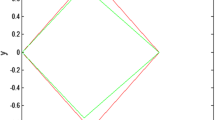Abstract
The fragmentation of interstellar molecular clouds has been investigated with great effort by many authors. In this paper, a simple model is given to describe the dynamics of two fragments moving in a special cylindrical potential. Using a modified version of the restricted three-body problem and the corresponding Jacobian integral, some constraints are given for the motion of the fragments.



Similar content being viewed by others
References
André, P., Men’shchikov, A., Bontemps, S., Könyves, V., Motte, F., Schneider, N., et al.: From filamentary clouds to prestellar cores to the stellar IMF: initial highlights from the Herschel Gould Belt survey. A&A 518, L102 (2010)
Binney, J., Tremaine, S.: Galactic Dynamics. Princeton Series In Astrophysics. Princeton University Press, Princeton (1987)
Curry, C.L.: Embedded, self-gravitating equilibria in sheetlike and filamentary molecular clouds. ApJ 541, 831–840 (2000)
Fiege, J.D., Pudritz, R.E.: Helical fields and filamentary molecular clouds—i. MNRAS 311, 85–104 (2000)
Fischera, J., Martin, P.G.: Physical properties of interstellar filaments. A&A 542, A77 (2012)
Juvela, M., Ristorcelli, I., Pagani, L., Doi, Y., Pelkonen, V.-M., Marshall, D.J.: Galactic cold cores. iii. General cloud properties. A&A 541, A12 (2012)
Langer, W.D., Velusamy, T., Kuiper, T.B.H., Levin, S., Olsen, E., Migenes, V.: Study of structure and small-scale fragmentation in TMC-1. ApJ 453, 293 (1995)
McKee, C.F., Zweibel, E.G., Goodman, A.A., Heiles, C.: Magnetic fields in star-forming regions – theory. In: Levy, E.H., Lunine, J.I. (eds.) Protostars and Planets III, p. 327 (1993). http://adsabs.harvard.edu/abs/1993prpl.conf..327M
Men’shchikov, A., André, P., Didelon, P., Könyves, V., Schneider, N., Motte, F.: Filamentary structures and compact objects in the Aquila and Polaris clouds observed by Herschel. A&A 518, L103 (2010)
Morris, R.: The dilogarithm function of a real argument. Math. Comp. 33, 778–787 (1979)
Ostriker, J.: The equilibrium of polytropic and isothermal cylinders. ApJ 140, 1056 (1964)
Plummer, H.C.: On the problem of distribution in globular star clusters. MNRAS 71, 460–470 (1911)
Schmid-Burgk, J.: Finite amplitude density variations in a self-gravitating isothermal gas layer. ApJ 149, 727 (1967)
Stodólkiewicz, J.S.: On the gravitational instability of some magneto-hydrodynamical systems of astrophysical interest. Part iii. Acta Astron. 13, 30–54 (1963)
Szebehely, V.: Theory of Orbits-The Restricted Problem of Three Bodies. Academic Press, Cambridge (1967)
Acknowledgements
The first author is grateful for discussions with Drs H. Klahr, F. Biscani and B. Kocsis. This research was partly supported by the OTKA Grant NN-111016.
Author information
Authors and Affiliations
Corresponding author
Ethics declarations
Conflict of interest
The authors declare that they have no conflict of interest.
Appendix
Appendix
Here, we investigate the linear stability of the collinear equilibrium point found above. First, Eqs. (24) and (25) are linearized (that is, we investigate their behavior at \(x=x_0+\xi \) and \(y=0+\,\eta \), \(x_0\) and 0 being the coordinates of the equilibrium points):
Assuming the solution in the form \(\xi = A e^{\lambda t}\) and \(\eta = B e^{\lambda t}\) with \(A \ne 0\) and \(B \ne 0\), substitution yields
This leads to the characteristic equation with \(\Lambda = \lambda ^2\)
An equilibrium point is stable if and only if \(\Lambda _1, \Lambda _2 < 0\) and real.
Let
and
so that
1.1 \(x_0>b\), the case of \(L_1\)
As \(3x_0^2 > b^2\), the first bracket in C is positive. Using Eq. (30), the second bracket is
In conclusion, C is negative. As \(\Lambda _{1,2}=(-B\pm \sqrt{B^2-4C})/2\) and \(B^2-4C>|B|\), there is always a positive \(\Lambda \) which results in instability.
1.2 \(x_0<-\,b\), the case of \(L_3\)
The first bracket in C is positive again. However, in this case
which concludes that C itself is positive. Equation (39) determines a parabola, which has negative roots if both the position (\(-B/2\)) and the value (\(-B^2/4+C\)) of its minimum are negative. Then, the following equations are to be solved:
and
Assuming again that \(b=0.1\) (see Sect. 4), the condition of stability is \(-\,1.13< x_0 <-\,0.1\) or \(m_1<1.08\), which seems physically reasonable.
Rights and permissions
About this article
Cite this article
Deme, B., Érdi, B. & Tóth, L.V. The restricted three-body problem in cylindrical clouds. Celest Mech Dyn Astr 130, 73 (2018). https://doi.org/10.1007/s10569-018-9869-x
Received:
Revised:
Accepted:
Published:
DOI: https://doi.org/10.1007/s10569-018-9869-x



